Java Fig: Ficus lacor Uses, Research, Remedies, Side Effects
Plaksha- Ficus lacor is an Ayurvedic tree used for the treatment of bleeding disorders, herpes, wounds, mouth ulcers, diarrhea and leucorrhea. Its common name is Java Fig.
Latin name- Ficus lacor Buch. Ham.
Family-Moraceae (Vata kula)
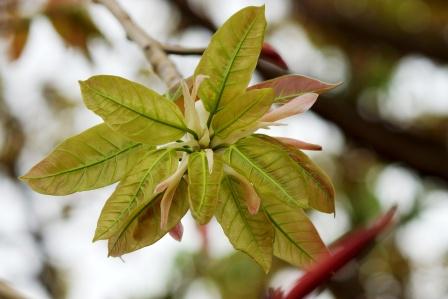
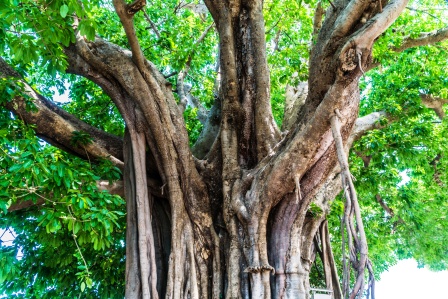
Table of Contents
Vernacular names
Names in different languages:
Hindi name-Pakar, Pakadi
English name- Java fig
Gujarathi name- Pepari
Kannada name- Basari mara
Malayalam name- Chela
Marathi name- Basari
Tamil name- Jovvi
Telugu name- Juvvi
Morphology
Plaksha is a medium to large tree found in the temperate climate of India. The bark of the tree is pale brown colored. The leaves are 4-5 inch long, renal shaped to oval with 6-10 vein in them. The fruits of the plant are round, small and pale red to whitish colored. The fruits and flowers are seen in the month of April-June.
Properties, part used, dosage
Properties:
Rasa (Taste) – Kashaya (Astringent)
Guna (Qualities) – Guru (Heavy), Ruksha (Dry)
Vipaka – Katu (Undergoes pungent taste after digestion)
Veerya (Potency) – Sheeta (Cold)
Karma (Actions) – Kapha pitta shamaka (reduces vitiated kapha and pitta dosha)
Pharmacological action – Anti inflammatory, Anti ulcer,
Part used- Bark, Latex
Dosage-
Decoction- 50 to 100 ml
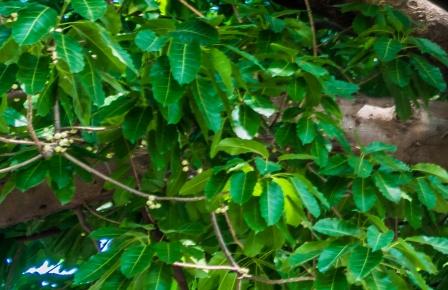
Chemical composition
Chemical composition of Ficus lacor
The leaves of the tree contain flavonoids including sorbifolin and scutellarein. Leaves also yield triterpenoids, lupeol and alpha, beta amyrin. The bark of the tree contains lanosterol, beta- sitosterol, caffeic acid, bergenin, methyl ricinolate and sugars.
Uses
Medicinal uses of Java fig – Plaksa:
- The fine powder of the dried bark of Plaksha is sprinkled over wounds and bleeding spots as part of treatment.
- Decoction of the bark of Ficus lacor is used for gargling to treat mouth ulcer and gingivitis.
- Decoction of the bark of Plaksha is given in a dose of 50-70 ml to treat diarrhea, leucorrhea and control blood sugar level in diabetes.
- Cold infusion prepared from the bark of Ficus lacor is used to treat nausea, vertigo and epileptic seizures.
- Paste prepared from the bark of the tree of Plaksha is applied over the area effected with Herpes and wounds.
Sanskrit verse
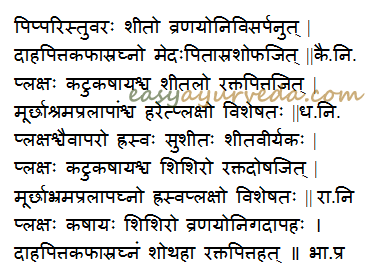
Traditional uses, Indications
Traditional Ayurvedic uses of Ficus lacor:
Tuvara – astringent
Sheetala – coolant
Indicated in –
Daha – burning sensation, as in gastritis, neuropathy, burning sensation in eyes etc
Asra – blood disorders such as abscess, skin disorders, bleeding disorders such as menorrhagia, nasal bleeding etc.
Meda – fat, obesity
Shopha – inflammation
Murcha – fainting, loss of consciousness
Shrama – tiredness, fatigue
Pralapa – irrelevant talk
Vrana – Ulcers, wounds
Yonigada – Vaginal infection, excessive bleeding, uterine disorders
Adverse effect
No adverse effect is known or reported from the use of Plaksha.
Interaction with medicines, supplements
Can this be used while taking Homeopathic medicine?
Yes. This product does not react with homeopathic medicine.
Can this medicine be continued while taking supplements like multivitamin tablets, Omega 3 fatty acids etc?
Yes. Generally, this product goes well with most dietary supplements. However, if you are taking more than one product per day, please consult your doctor for an opinion.
With western
medicines
Seek your
doctor’s advice if you are taking this product along with other western
(allopathic / modern) medicines. Some Ayurvedic herbs can interact with modern
medicine.
If both Ayurvedic and allopathic medicines are advised together, then it is
best to take Allopathic medicine first, wait for 30 minutes and then take the
Ayurvedic medicine.
Ayurvedic medicines
Ayurvedic medicines containing Plaksh:
Nyagrodadhi kashaya: It is a decoction for the treatment of diarrhea, obesity, heavy bleeding during menstruation, wound and pitta predominant disorder.
Nalpamaradi oil: It is an oil used externally for the treatment of skin diseases, Herpes etc and to improve the fairness of the skin.
Panchavalkaladi tailam: It is an oil useful to treat eczema, dermatitis, herpes and skin conditions with bleeding, oozing and secretions.
Marma gulika: It is a tablet used in Ayurvedic treatment of diseases of vital organs, means, diseases related to heart, brain, urinary system etc. It is also used to treat external injury to vital organs of the body.
Kumkumadi taila: It is Ayurvedic herbal oil used for face massage. It is helpful to improve skin texture, complexion and also to relieve skin problems such as acne, scars etc.
Research
Research articles about Ficus lacor:
Anti- arthritic potential: The present study was carried out to evaluate antiarthritic potential and phytochemical screening of various extracts of Ficus lacor aerial roots. The antiarthritic activity was evaluated by adjuvant-induced arthritis at the dose of 50 and 100 mg/kg body weight and the standard drug used was indomethacin. In conclusion, we demonstrate that, at 100 mg/kg body weight, doses of FLPE and PLET extracts were highly effective in preventing and suppressing the development of adjuvant-induced arthritis.
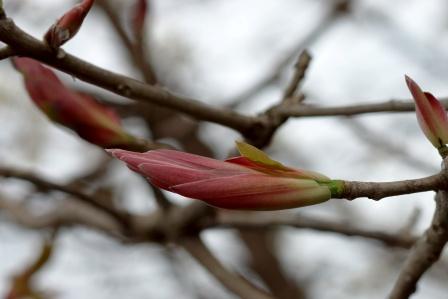
Hepato- protective action: The ethanolic extract of the bark of Ficus lacor Buch.-Ham. was evaluated for its hepatoprotective activity on experimentally induced liver injury with CCl4 by using biochemical parameters such as SGOT, SGPT and total bilirubin. It was observed that the ethanolic extract showed a considerable degree of protection against CCl4 challenge.
Classical categorization
Charaka Samhita- Mutra sangrahaniya – group of herbs that increase urine volume /retention,
Kashaya skandha – astringent tasting group of herbs
Sushruta Samhita- Nyagrodhadi gana
Vagbhata- Nyagrodadi gana
Dhanvantari Nighantu- Amradi varga
Kaiyyadeva Nighantu- Oushadhi varga
Raja Nighantu- Amradi varga
Scientific classification
Kingdom: Plantae
Order: Rosales
Family: Moraceae
Genus: Ficus
Species: F. lacor
Sanskrit synonyms
Sanskrit synonyms of Plaksha –
Ashwattha Patraka – leaves resemble those of Bodhi tree – icus religiosa.
Charudarshana – Tree is gigantic and beautiful to look at.
Mahabala, Drudhapraroha – strong roots and stem
Mangalacchaya – auspicious
hrasvaparna – short leaves
Parkati, Jati, Pippari, Pimpari, Shrungika, Vaati, Gardabhanda, Kamandalu, Plava, Gandhamunda, Mugdhika,
Pugamunda, Charudaru, Suparshva
Kapeetana, Kapeetaka, Varoha Shakhi,
Author: Dr.B.K.Prashanth M.D (Ayu), Ph.D
E mail: [email protected]
Click to consult Dr Prashanth BK
Sthanika Karma (Systemic Action)
External Application – It has wound healing, Anti inflammatory and blood purifying action. Its bark powder is indicated in various inflammatory and bleeding conditions, wounds, and skin diseases. Can be used for gargling in mouth ulcers.
Internal administration-
Nervous system – Indicated in giddiness, restlessness etc.
Digestive system – Absorbent in nature. Indicated in vomiting, diarrhea
Circulatory System – Indicated in Bleeding disorders.
Reproductive system – Indicated in female reproductive disorders like leukorrhea, menorrhagia etc.
Excretory system – reduces urine output. indicated in diabetes.
Tapakrama – Daha prasamana (cures burning sensation











One comment
Ankit pandey
Very useful sir, tqs for provided us such type of materials